Leadership Management Report: Theories, Styles, and Powers
VerifiedAdded on 2022/08/27
|13
|3429
|15
Report
AI Summary
This report delves into the core concepts of leadership and management, exploring what distinguishes effective leaders, contrasting leadership with management, and analyzing the various power bases leaders utilize to exert influence. It examines different management styles, including autocratic, democratic, and laissez-faire approaches, highlighting their respective advantages and disadvantages. The report also discusses the application of leadership theories, providing a comprehensive understanding of the practical aspects of leadership and management within organizational contexts. The report provides a detailed overview of key concepts, including leader qualities, the differences between leadership and management, and the application of power within leadership roles. Furthermore, it offers insights into different management styles and explores several leadership theories, providing a comprehensive understanding of leadership and management in organizational settings.
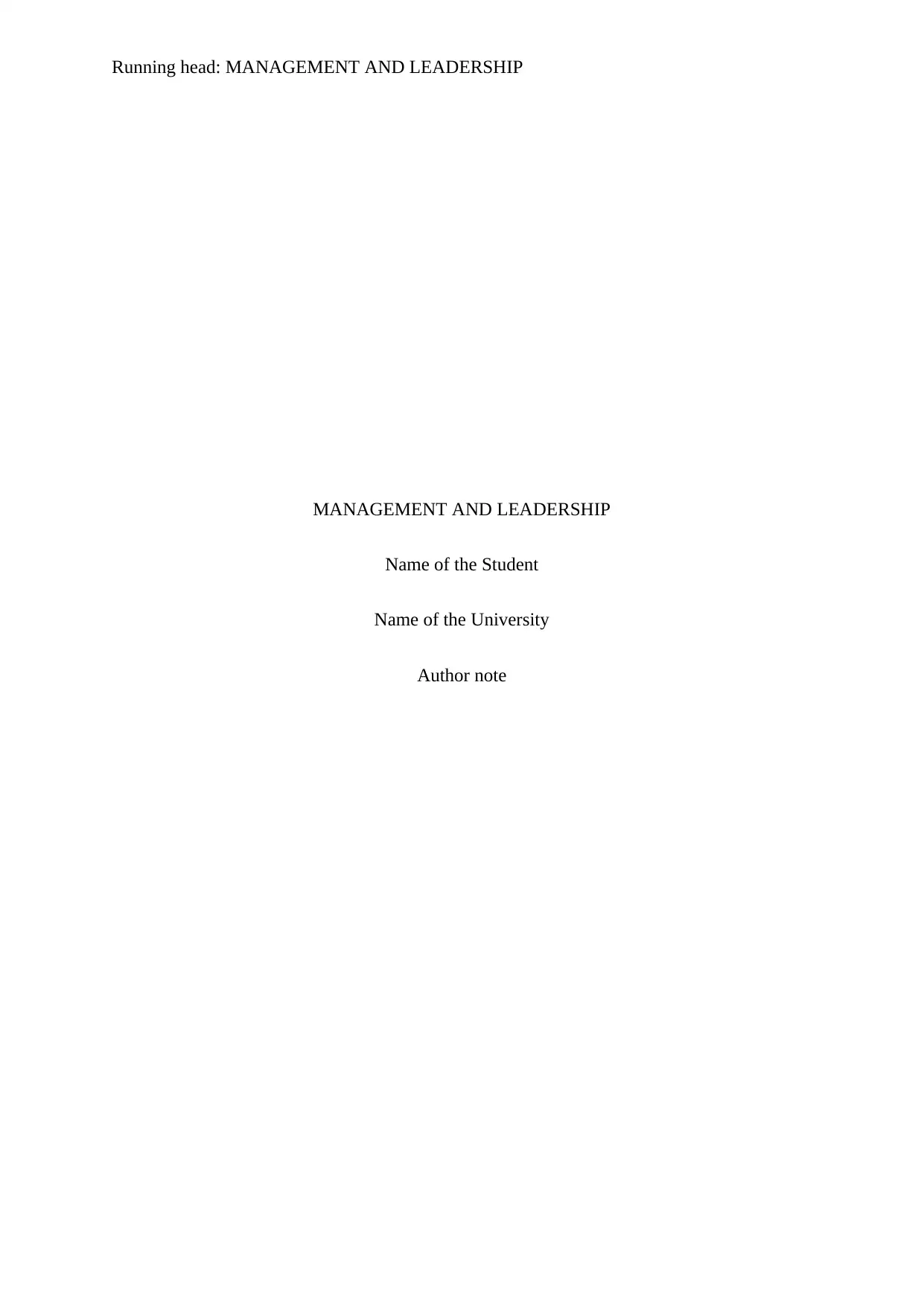
Running head: MANAGEMENT AND LEADERSHIP
MANAGEMENT AND LEADERSHIP
Name of the Student
Name of the University
Author note
MANAGEMENT AND LEADERSHIP
Name of the Student
Name of the University
Author note
Paraphrase This Document
Need a fresh take? Get an instant paraphrase of this document with our AI Paraphraser

1MANAGEMENT AND LEADERSHIP
1) Qualities of a leader
A leader is the one who has qualities like the potential to respect others, show empathy
and care to the followers, and the most important quality of a leader is the capability of
motivating and inspiring others for a noble cause (Maxwell, 2007). The major role played by
a leader in any individual’s life is to influence him/her towards the goals and objectives set to
achieve. For a leader, it is very important that he has the complete knowledge of the team
members of the team he is in. This will help the leader in a better understanding of the
people, and their requirements, and this gesture will also help in making the team competent
and full of confidence.
There are certain qualities of leaders that make them unique from others. Some of them
are discussed below:
A leader is the one who is a difference maker between the failure and the success. A
leader must be someone who sets good examples for others to follow and should have a
positive approach towards anything he does, and whatever he does must be visible through
the actions he does for everyone (Bethel, 2012).
It is important that the leader is able to permeate new energies to the team member he has
as this will help the team to perform better in the hard times and usually too. The vision of the
team must be clearly communicated about the vision the team has to follow, and the leader is
the one who is responsible for directing his team towards these visions which will help in the
achievement of the goals and objectives (Meng et al., 2012).
There are and will be times when some hard and tough decisions are to be taken by the
leader for the team. Hence, a leader must have good decision making capabilities and should
be able to make a decision that has a profound impact on the followers he has.
1) Qualities of a leader
A leader is the one who has qualities like the potential to respect others, show empathy
and care to the followers, and the most important quality of a leader is the capability of
motivating and inspiring others for a noble cause (Maxwell, 2007). The major role played by
a leader in any individual’s life is to influence him/her towards the goals and objectives set to
achieve. For a leader, it is very important that he has the complete knowledge of the team
members of the team he is in. This will help the leader in a better understanding of the
people, and their requirements, and this gesture will also help in making the team competent
and full of confidence.
There are certain qualities of leaders that make them unique from others. Some of them
are discussed below:
A leader is the one who is a difference maker between the failure and the success. A
leader must be someone who sets good examples for others to follow and should have a
positive approach towards anything he does, and whatever he does must be visible through
the actions he does for everyone (Bethel, 2012).
It is important that the leader is able to permeate new energies to the team member he has
as this will help the team to perform better in the hard times and usually too. The vision of the
team must be clearly communicated about the vision the team has to follow, and the leader is
the one who is responsible for directing his team towards these visions which will help in the
achievement of the goals and objectives (Meng et al., 2012).
There are and will be times when some hard and tough decisions are to be taken by the
leader for the team. Hence, a leader must have good decision making capabilities and should
be able to make a decision that has a profound impact on the followers he has.
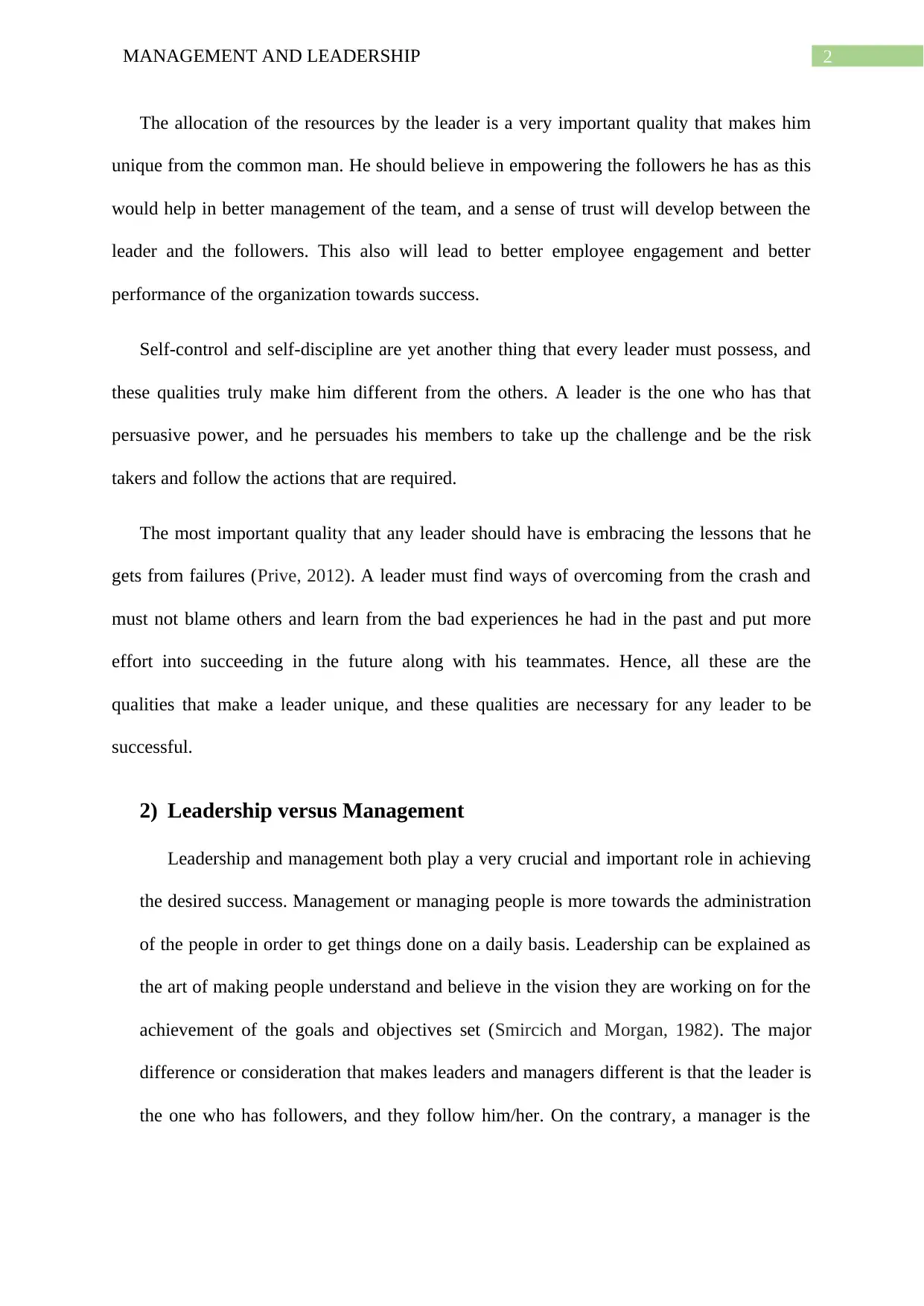
2MANAGEMENT AND LEADERSHIP
The allocation of the resources by the leader is a very important quality that makes him
unique from the common man. He should believe in empowering the followers he has as this
would help in better management of the team, and a sense of trust will develop between the
leader and the followers. This also will lead to better employee engagement and better
performance of the organization towards success.
Self-control and self-discipline are yet another thing that every leader must possess, and
these qualities truly make him different from the others. A leader is the one who has that
persuasive power, and he persuades his members to take up the challenge and be the risk
takers and follow the actions that are required.
The most important quality that any leader should have is embracing the lessons that he
gets from failures (Prive, 2012). A leader must find ways of overcoming from the crash and
must not blame others and learn from the bad experiences he had in the past and put more
effort into succeeding in the future along with his teammates. Hence, all these are the
qualities that make a leader unique, and these qualities are necessary for any leader to be
successful.
2) Leadership versus Management
Leadership and management both play a very crucial and important role in achieving
the desired success. Management or managing people is more towards the administration
of the people in order to get things done on a daily basis. Leadership can be explained as
the art of making people understand and believe in the vision they are working on for the
achievement of the goals and objectives set (Smircich and Morgan, 1982). The major
difference or consideration that makes leaders and managers different is that the leader is
the one who has followers, and they follow him/her. On the contrary, a manager is the
The allocation of the resources by the leader is a very important quality that makes him
unique from the common man. He should believe in empowering the followers he has as this
would help in better management of the team, and a sense of trust will develop between the
leader and the followers. This also will lead to better employee engagement and better
performance of the organization towards success.
Self-control and self-discipline are yet another thing that every leader must possess, and
these qualities truly make him different from the others. A leader is the one who has that
persuasive power, and he persuades his members to take up the challenge and be the risk
takers and follow the actions that are required.
The most important quality that any leader should have is embracing the lessons that he
gets from failures (Prive, 2012). A leader must find ways of overcoming from the crash and
must not blame others and learn from the bad experiences he had in the past and put more
effort into succeeding in the future along with his teammates. Hence, all these are the
qualities that make a leader unique, and these qualities are necessary for any leader to be
successful.
2) Leadership versus Management
Leadership and management both play a very crucial and important role in achieving
the desired success. Management or managing people is more towards the administration
of the people in order to get things done on a daily basis. Leadership can be explained as
the art of making people understand and believe in the vision they are working on for the
achievement of the goals and objectives set (Smircich and Morgan, 1982). The major
difference or consideration that makes leaders and managers different is that the leader is
the one who has followers, and they follow him/her. On the contrary, a manager is the
⊘ This is a preview!⊘
Do you want full access?
Subscribe today to unlock all pages.

Trusted by 1+ million students worldwide
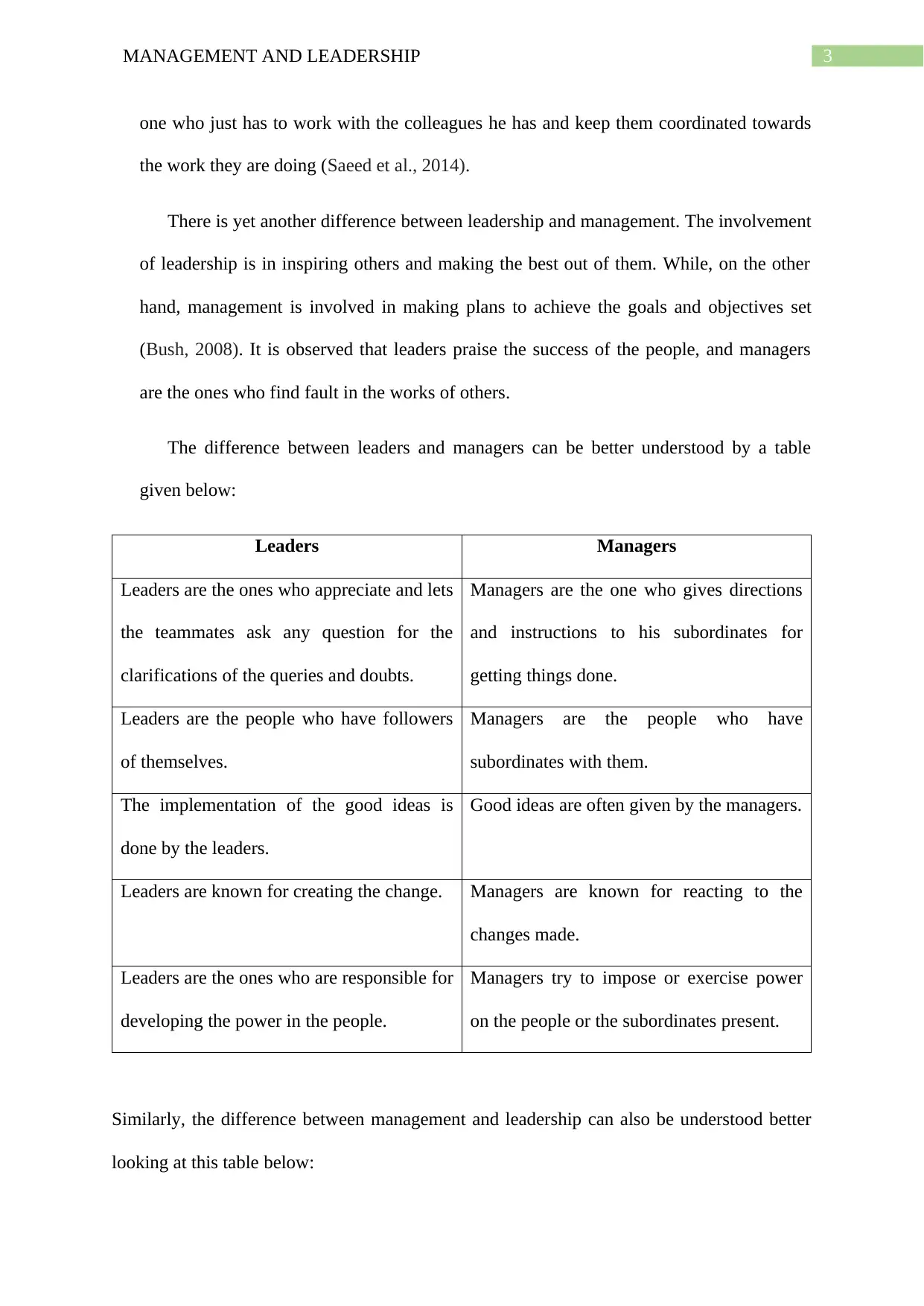
3MANAGEMENT AND LEADERSHIP
one who just has to work with the colleagues he has and keep them coordinated towards
the work they are doing (Saeed et al., 2014).
There is yet another difference between leadership and management. The involvement
of leadership is in inspiring others and making the best out of them. While, on the other
hand, management is involved in making plans to achieve the goals and objectives set
(Bush, 2008). It is observed that leaders praise the success of the people, and managers
are the ones who find fault in the works of others.
The difference between leaders and managers can be better understood by a table
given below:
Leaders Managers
Leaders are the ones who appreciate and lets
the teammates ask any question for the
clarifications of the queries and doubts.
Managers are the one who gives directions
and instructions to his subordinates for
getting things done.
Leaders are the people who have followers
of themselves.
Managers are the people who have
subordinates with them.
The implementation of the good ideas is
done by the leaders.
Good ideas are often given by the managers.
Leaders are known for creating the change. Managers are known for reacting to the
changes made.
Leaders are the ones who are responsible for
developing the power in the people.
Managers try to impose or exercise power
on the people or the subordinates present.
Similarly, the difference between management and leadership can also be understood better
looking at this table below:
one who just has to work with the colleagues he has and keep them coordinated towards
the work they are doing (Saeed et al., 2014).
There is yet another difference between leadership and management. The involvement
of leadership is in inspiring others and making the best out of them. While, on the other
hand, management is involved in making plans to achieve the goals and objectives set
(Bush, 2008). It is observed that leaders praise the success of the people, and managers
are the ones who find fault in the works of others.
The difference between leaders and managers can be better understood by a table
given below:
Leaders Managers
Leaders are the ones who appreciate and lets
the teammates ask any question for the
clarifications of the queries and doubts.
Managers are the one who gives directions
and instructions to his subordinates for
getting things done.
Leaders are the people who have followers
of themselves.
Managers are the people who have
subordinates with them.
The implementation of the good ideas is
done by the leaders.
Good ideas are often given by the managers.
Leaders are known for creating the change. Managers are known for reacting to the
changes made.
Leaders are the ones who are responsible for
developing the power in the people.
Managers try to impose or exercise power
on the people or the subordinates present.
Similarly, the difference between management and leadership can also be understood better
looking at this table below:
Paraphrase This Document
Need a fresh take? Get an instant paraphrase of this document with our AI Paraphraser
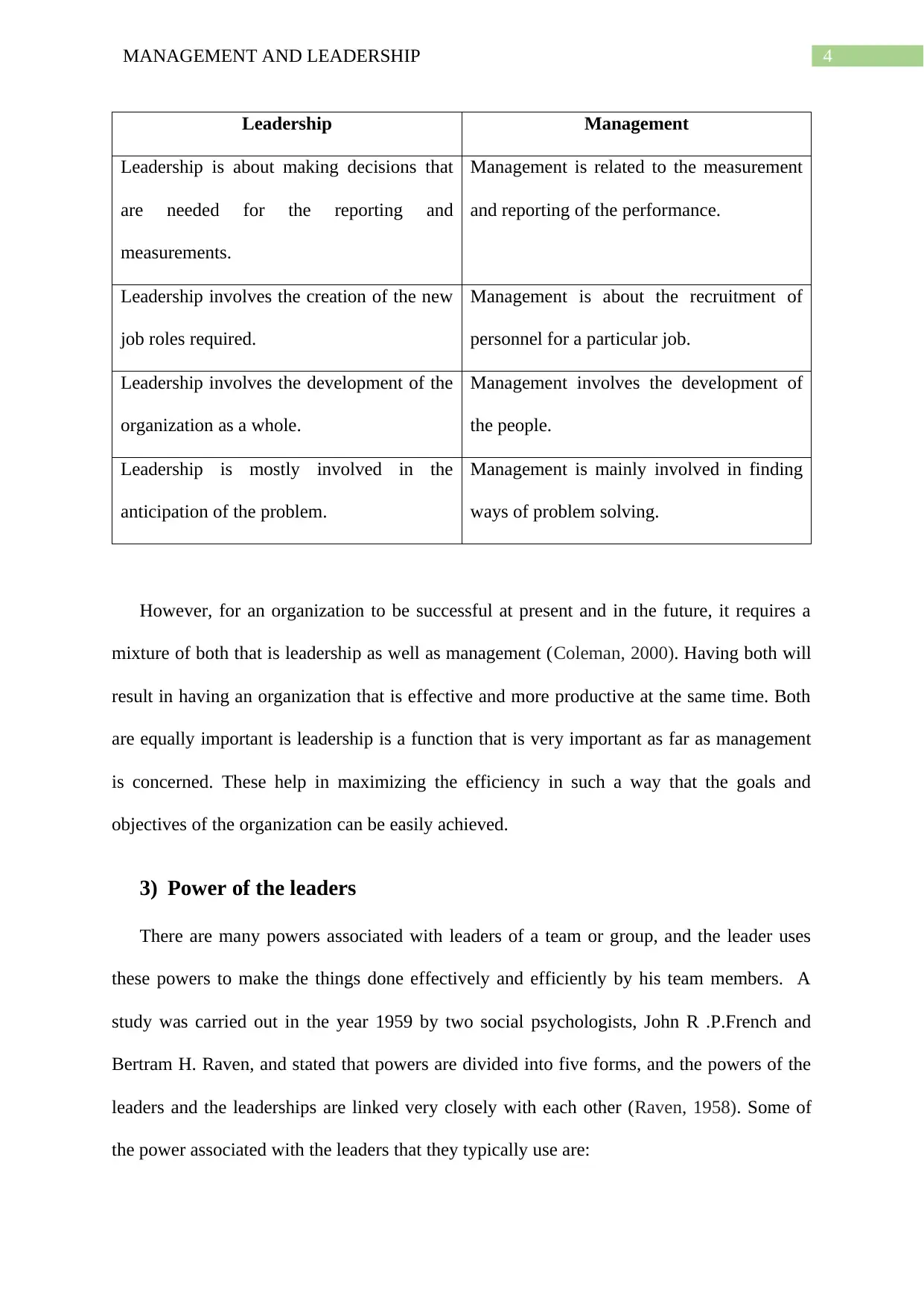
4MANAGEMENT AND LEADERSHIP
Leadership Management
Leadership is about making decisions that
are needed for the reporting and
measurements.
Management is related to the measurement
and reporting of the performance.
Leadership involves the creation of the new
job roles required.
Management is about the recruitment of
personnel for a particular job.
Leadership involves the development of the
organization as a whole.
Management involves the development of
the people.
Leadership is mostly involved in the
anticipation of the problem.
Management is mainly involved in finding
ways of problem solving.
However, for an organization to be successful at present and in the future, it requires a
mixture of both that is leadership as well as management (Coleman, 2000). Having both will
result in having an organization that is effective and more productive at the same time. Both
are equally important is leadership is a function that is very important as far as management
is concerned. These help in maximizing the efficiency in such a way that the goals and
objectives of the organization can be easily achieved.
3) Power of the leaders
There are many powers associated with leaders of a team or group, and the leader uses
these powers to make the things done effectively and efficiently by his team members. A
study was carried out in the year 1959 by two social psychologists, John R .P.French and
Bertram H. Raven, and stated that powers are divided into five forms, and the powers of the
leaders and the leaderships are linked very closely with each other (Raven, 1958). Some of
the power associated with the leaders that they typically use are:
Leadership Management
Leadership is about making decisions that
are needed for the reporting and
measurements.
Management is related to the measurement
and reporting of the performance.
Leadership involves the creation of the new
job roles required.
Management is about the recruitment of
personnel for a particular job.
Leadership involves the development of the
organization as a whole.
Management involves the development of
the people.
Leadership is mostly involved in the
anticipation of the problem.
Management is mainly involved in finding
ways of problem solving.
However, for an organization to be successful at present and in the future, it requires a
mixture of both that is leadership as well as management (Coleman, 2000). Having both will
result in having an organization that is effective and more productive at the same time. Both
are equally important is leadership is a function that is very important as far as management
is concerned. These help in maximizing the efficiency in such a way that the goals and
objectives of the organization can be easily achieved.
3) Power of the leaders
There are many powers associated with leaders of a team or group, and the leader uses
these powers to make the things done effectively and efficiently by his team members. A
study was carried out in the year 1959 by two social psychologists, John R .P.French and
Bertram H. Raven, and stated that powers are divided into five forms, and the powers of the
leaders and the leaderships are linked very closely with each other (Raven, 1958). Some of
the power associated with the leaders that they typically use are:
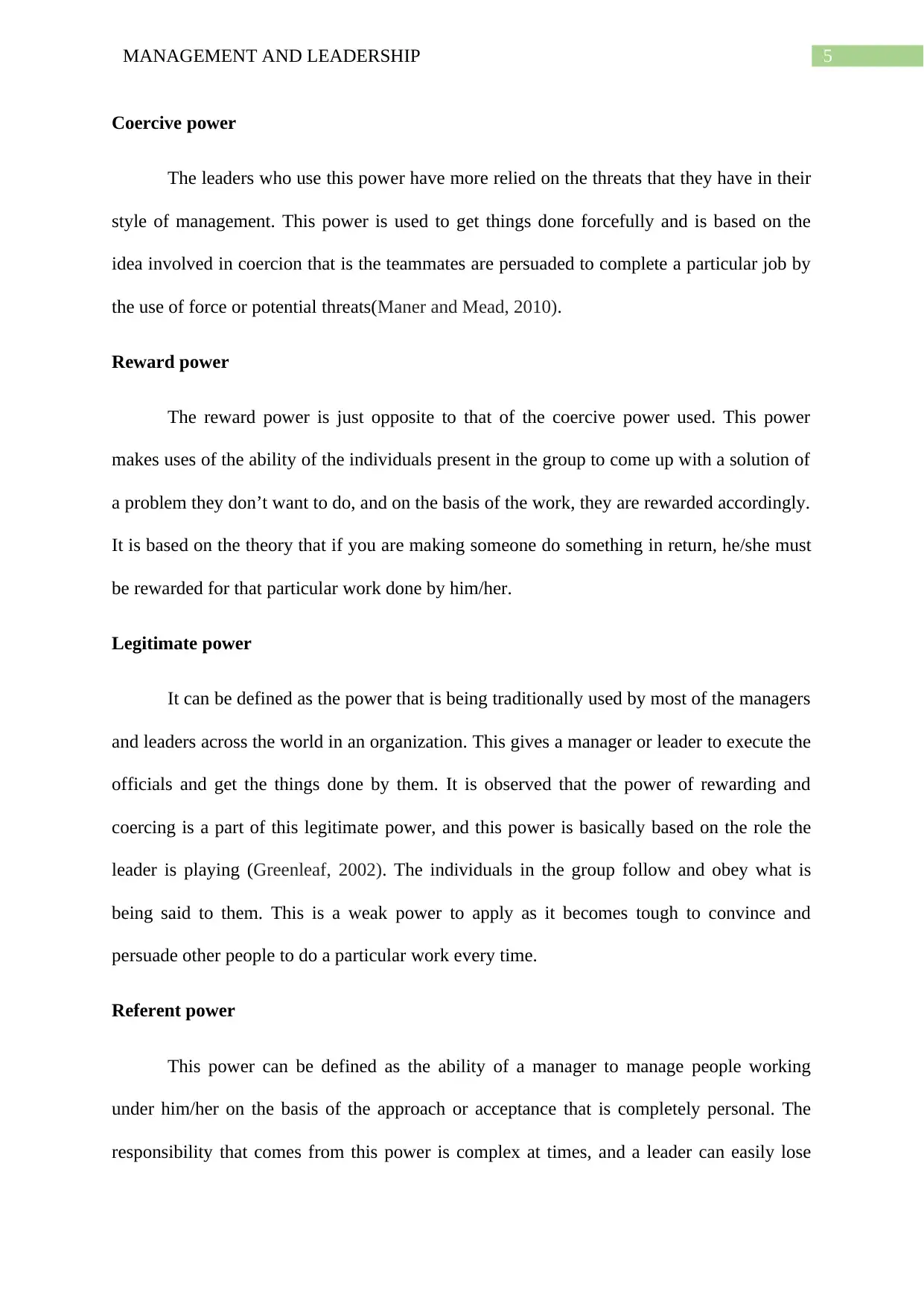
5MANAGEMENT AND LEADERSHIP
Coercive power
The leaders who use this power have more relied on the threats that they have in their
style of management. This power is used to get things done forcefully and is based on the
idea involved in coercion that is the teammates are persuaded to complete a particular job by
the use of force or potential threats(Maner and Mead, 2010).
Reward power
The reward power is just opposite to that of the coercive power used. This power
makes uses of the ability of the individuals present in the group to come up with a solution of
a problem they don’t want to do, and on the basis of the work, they are rewarded accordingly.
It is based on the theory that if you are making someone do something in return, he/she must
be rewarded for that particular work done by him/her.
Legitimate power
It can be defined as the power that is being traditionally used by most of the managers
and leaders across the world in an organization. This gives a manager or leader to execute the
officials and get the things done by them. It is observed that the power of rewarding and
coercing is a part of this legitimate power, and this power is basically based on the role the
leader is playing (Greenleaf, 2002). The individuals in the group follow and obey what is
being said to them. This is a weak power to apply as it becomes tough to convince and
persuade other people to do a particular work every time.
Referent power
This power can be defined as the ability of a manager to manage people working
under him/her on the basis of the approach or acceptance that is completely personal. The
responsibility that comes from this power is complex at times, and a leader can easily lose
Coercive power
The leaders who use this power have more relied on the threats that they have in their
style of management. This power is used to get things done forcefully and is based on the
idea involved in coercion that is the teammates are persuaded to complete a particular job by
the use of force or potential threats(Maner and Mead, 2010).
Reward power
The reward power is just opposite to that of the coercive power used. This power
makes uses of the ability of the individuals present in the group to come up with a solution of
a problem they don’t want to do, and on the basis of the work, they are rewarded accordingly.
It is based on the theory that if you are making someone do something in return, he/she must
be rewarded for that particular work done by him/her.
Legitimate power
It can be defined as the power that is being traditionally used by most of the managers
and leaders across the world in an organization. This gives a manager or leader to execute the
officials and get the things done by them. It is observed that the power of rewarding and
coercing is a part of this legitimate power, and this power is basically based on the role the
leader is playing (Greenleaf, 2002). The individuals in the group follow and obey what is
being said to them. This is a weak power to apply as it becomes tough to convince and
persuade other people to do a particular work every time.
Referent power
This power can be defined as the ability of a manager to manage people working
under him/her on the basis of the approach or acceptance that is completely personal. The
responsibility that comes from this power is complex at times, and a leader can easily lose
⊘ This is a preview!⊘
Do you want full access?
Subscribe today to unlock all pages.

Trusted by 1+ million students worldwide
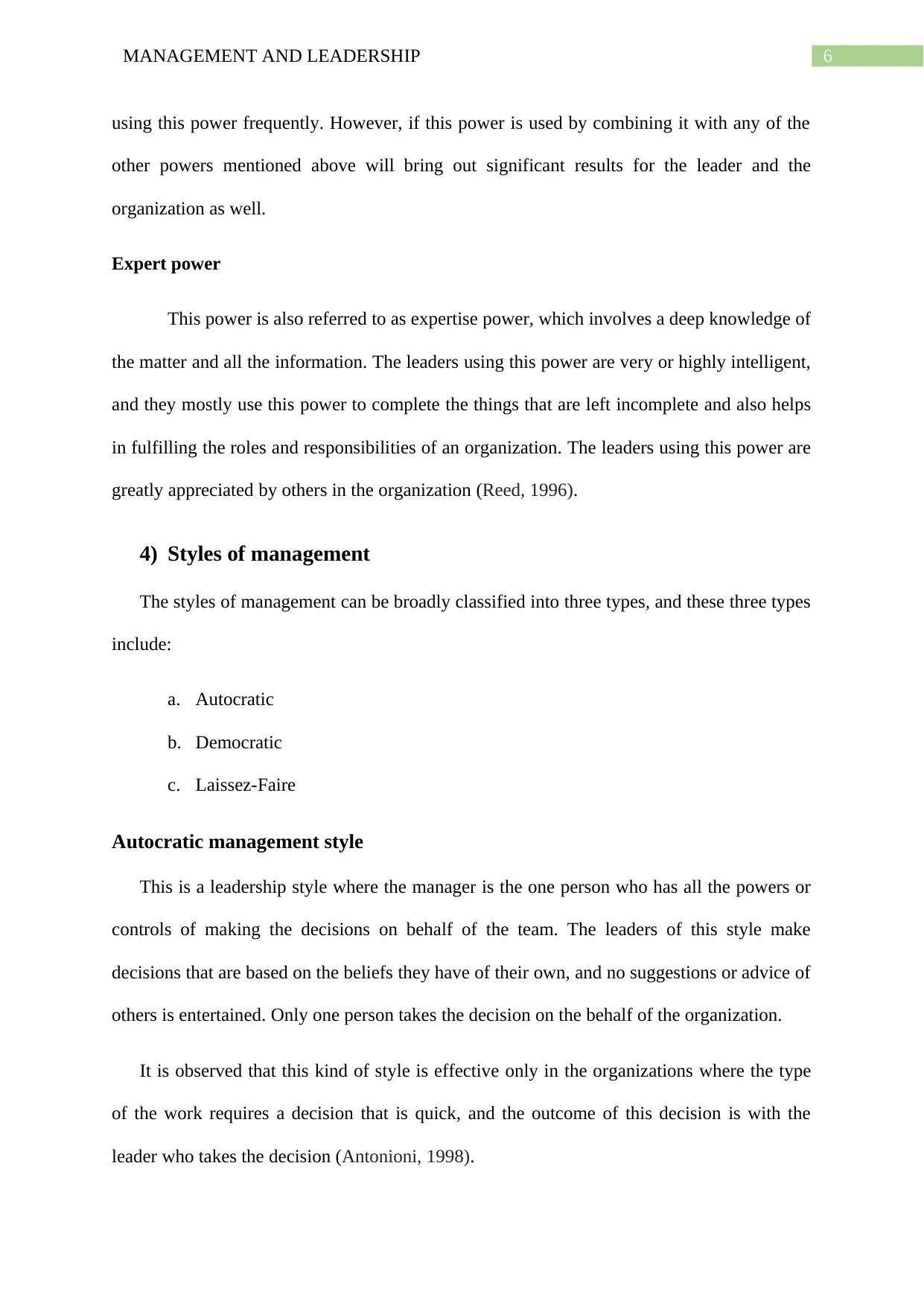
6MANAGEMENT AND LEADERSHIP
using this power frequently. However, if this power is used by combining it with any of the
other powers mentioned above will bring out significant results for the leader and the
organization as well.
Expert power
This power is also referred to as expertise power, which involves a deep knowledge of
the matter and all the information. The leaders using this power are very or highly intelligent,
and they mostly use this power to complete the things that are left incomplete and also helps
in fulfilling the roles and responsibilities of an organization. The leaders using this power are
greatly appreciated by others in the organization (Reed, 1996).
4) Styles of management
The styles of management can be broadly classified into three types, and these three types
include:
a. Autocratic
b. Democratic
c. Laissez-Faire
Autocratic management style
This is a leadership style where the manager is the one person who has all the powers or
controls of making the decisions on behalf of the team. The leaders of this style make
decisions that are based on the beliefs they have of their own, and no suggestions or advice of
others is entertained. Only one person takes the decision on the behalf of the organization.
It is observed that this kind of style is effective only in the organizations where the type
of the work requires a decision that is quick, and the outcome of this decision is with the
leader who takes the decision (Antonioni, 1998).
using this power frequently. However, if this power is used by combining it with any of the
other powers mentioned above will bring out significant results for the leader and the
organization as well.
Expert power
This power is also referred to as expertise power, which involves a deep knowledge of
the matter and all the information. The leaders using this power are very or highly intelligent,
and they mostly use this power to complete the things that are left incomplete and also helps
in fulfilling the roles and responsibilities of an organization. The leaders using this power are
greatly appreciated by others in the organization (Reed, 1996).
4) Styles of management
The styles of management can be broadly classified into three types, and these three types
include:
a. Autocratic
b. Democratic
c. Laissez-Faire
Autocratic management style
This is a leadership style where the manager is the one person who has all the powers or
controls of making the decisions on behalf of the team. The leaders of this style make
decisions that are based on the beliefs they have of their own, and no suggestions or advice of
others is entertained. Only one person takes the decision on the behalf of the organization.
It is observed that this kind of style is effective only in the organizations where the type
of the work requires a decision that is quick, and the outcome of this decision is with the
leader who takes the decision (Antonioni, 1998).
Paraphrase This Document
Need a fresh take? Get an instant paraphrase of this document with our AI Paraphraser
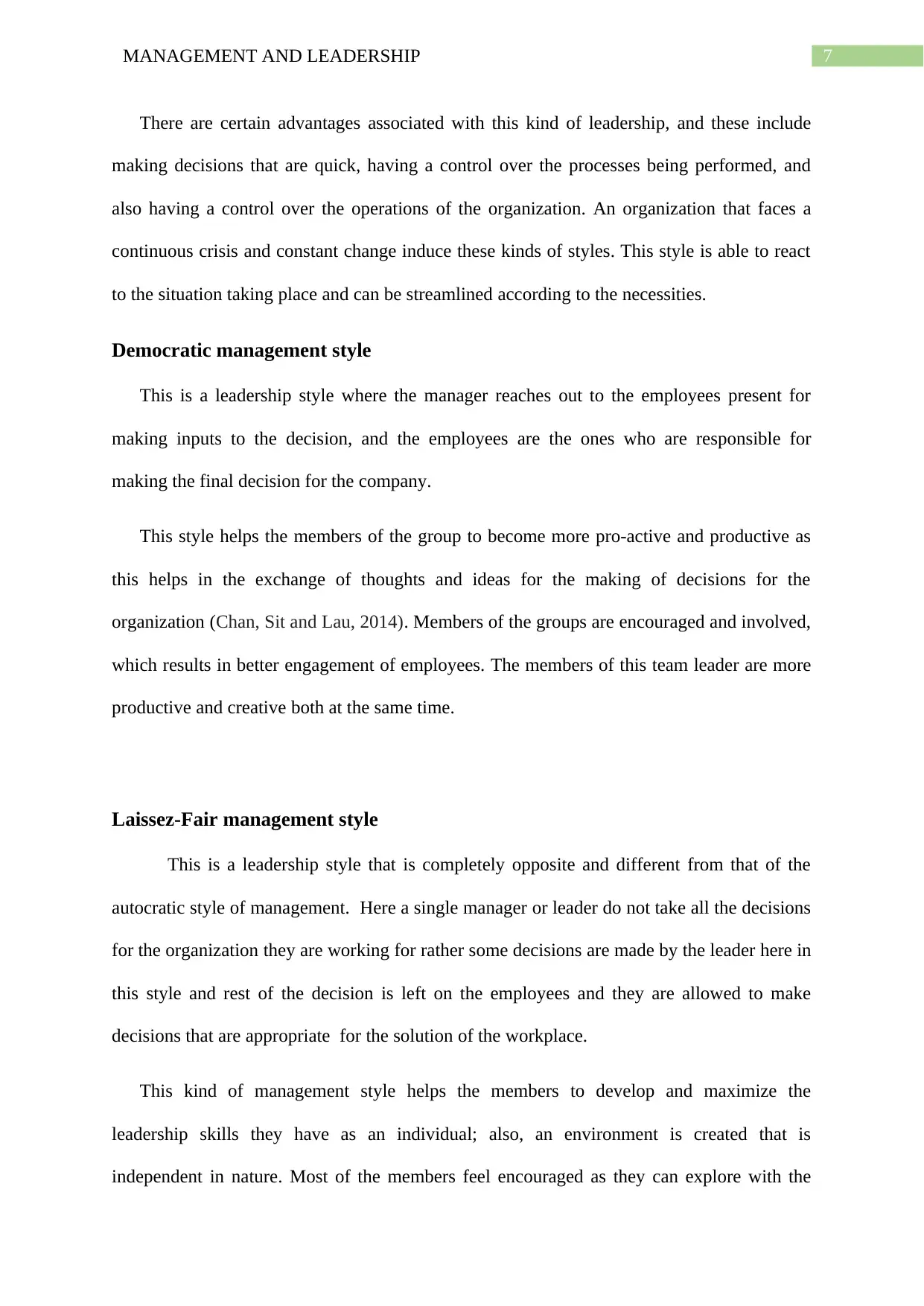
7MANAGEMENT AND LEADERSHIP
There are certain advantages associated with this kind of leadership, and these include
making decisions that are quick, having a control over the processes being performed, and
also having a control over the operations of the organization. An organization that faces a
continuous crisis and constant change induce these kinds of styles. This style is able to react
to the situation taking place and can be streamlined according to the necessities.
Democratic management style
This is a leadership style where the manager reaches out to the employees present for
making inputs to the decision, and the employees are the ones who are responsible for
making the final decision for the company.
This style helps the members of the group to become more pro-active and productive as
this helps in the exchange of thoughts and ideas for the making of decisions for the
organization (Chan, Sit and Lau, 2014). Members of the groups are encouraged and involved,
which results in better engagement of employees. The members of this team leader are more
productive and creative both at the same time.
Laissez-Fair management style
This is a leadership style that is completely opposite and different from that of the
autocratic style of management. Here a single manager or leader do not take all the decisions
for the organization they are working for rather some decisions are made by the leader here in
this style and rest of the decision is left on the employees and they are allowed to make
decisions that are appropriate for the solution of the workplace.
This kind of management style helps the members to develop and maximize the
leadership skills they have as an individual; also, an environment is created that is
independent in nature. Most of the members feel encouraged as they can explore with the
There are certain advantages associated with this kind of leadership, and these include
making decisions that are quick, having a control over the processes being performed, and
also having a control over the operations of the organization. An organization that faces a
continuous crisis and constant change induce these kinds of styles. This style is able to react
to the situation taking place and can be streamlined according to the necessities.
Democratic management style
This is a leadership style where the manager reaches out to the employees present for
making inputs to the decision, and the employees are the ones who are responsible for
making the final decision for the company.
This style helps the members of the group to become more pro-active and productive as
this helps in the exchange of thoughts and ideas for the making of decisions for the
organization (Chan, Sit and Lau, 2014). Members of the groups are encouraged and involved,
which results in better engagement of employees. The members of this team leader are more
productive and creative both at the same time.
Laissez-Fair management style
This is a leadership style that is completely opposite and different from that of the
autocratic style of management. Here a single manager or leader do not take all the decisions
for the organization they are working for rather some decisions are made by the leader here in
this style and rest of the decision is left on the employees and they are allowed to make
decisions that are appropriate for the solution of the workplace.
This kind of management style helps the members to develop and maximize the
leadership skills they have as an individual; also, an environment is created that is
independent in nature. Most of the members feel encouraged as they can explore with the
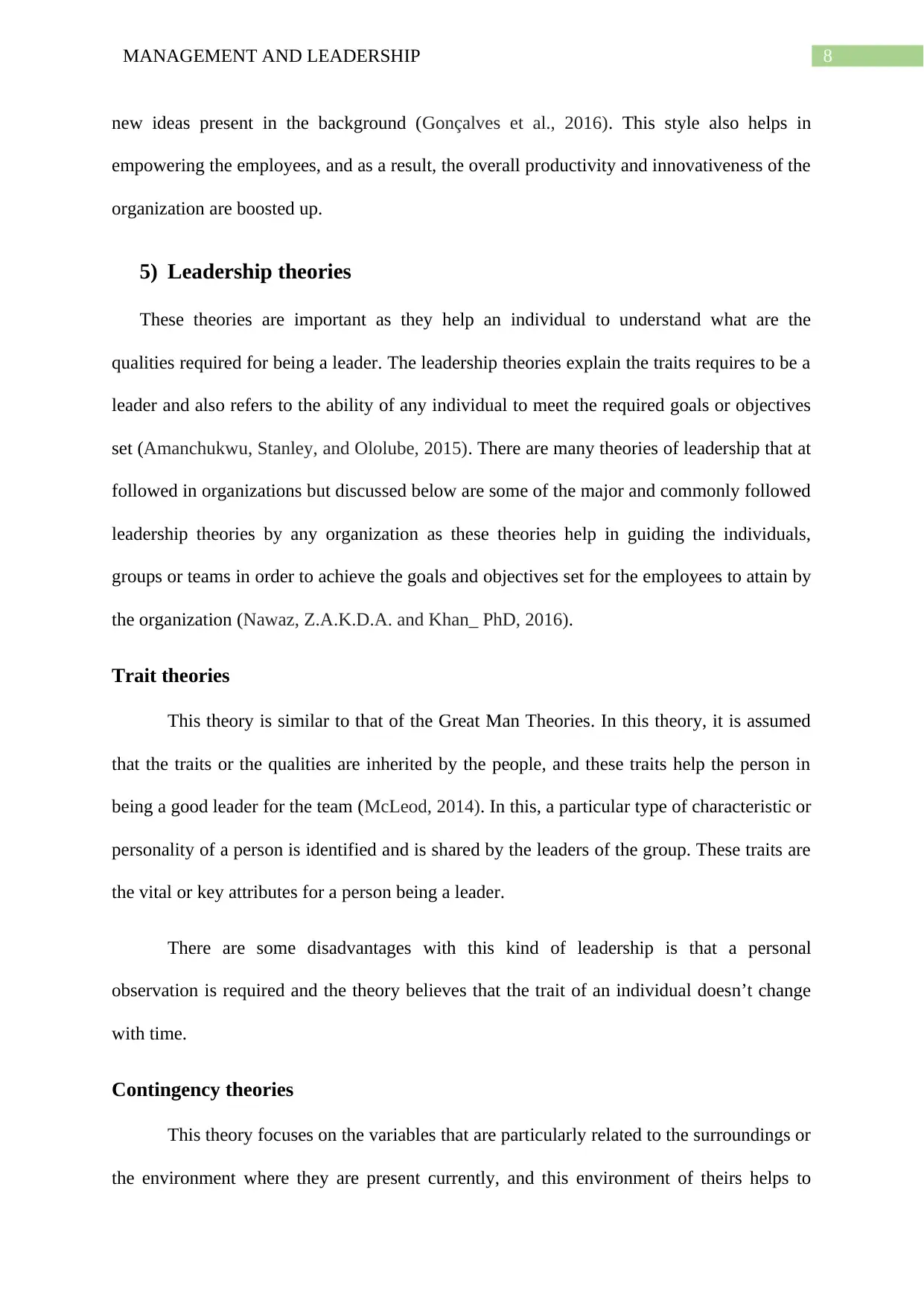
8MANAGEMENT AND LEADERSHIP
new ideas present in the background (Gonçalves et al., 2016). This style also helps in
empowering the employees, and as a result, the overall productivity and innovativeness of the
organization are boosted up.
5) Leadership theories
These theories are important as they help an individual to understand what are the
qualities required for being a leader. The leadership theories explain the traits requires to be a
leader and also refers to the ability of any individual to meet the required goals or objectives
set (Amanchukwu, Stanley, and Ololube, 2015). There are many theories of leadership that at
followed in organizations but discussed below are some of the major and commonly followed
leadership theories by any organization as these theories help in guiding the individuals,
groups or teams in order to achieve the goals and objectives set for the employees to attain by
the organization (Nawaz, Z.A.K.D.A. and Khan_ PhD, 2016).
Trait theories
This theory is similar to that of the Great Man Theories. In this theory, it is assumed
that the traits or the qualities are inherited by the people, and these traits help the person in
being a good leader for the team (McLeod, 2014). In this, a particular type of characteristic or
personality of a person is identified and is shared by the leaders of the group. These traits are
the vital or key attributes for a person being a leader.
There are some disadvantages with this kind of leadership is that a personal
observation is required and the theory believes that the trait of an individual doesn’t change
with time.
Contingency theories
This theory focuses on the variables that are particularly related to the surroundings or
the environment where they are present currently, and this environment of theirs helps to
new ideas present in the background (Gonçalves et al., 2016). This style also helps in
empowering the employees, and as a result, the overall productivity and innovativeness of the
organization are boosted up.
5) Leadership theories
These theories are important as they help an individual to understand what are the
qualities required for being a leader. The leadership theories explain the traits requires to be a
leader and also refers to the ability of any individual to meet the required goals or objectives
set (Amanchukwu, Stanley, and Ololube, 2015). There are many theories of leadership that at
followed in organizations but discussed below are some of the major and commonly followed
leadership theories by any organization as these theories help in guiding the individuals,
groups or teams in order to achieve the goals and objectives set for the employees to attain by
the organization (Nawaz, Z.A.K.D.A. and Khan_ PhD, 2016).
Trait theories
This theory is similar to that of the Great Man Theories. In this theory, it is assumed
that the traits or the qualities are inherited by the people, and these traits help the person in
being a good leader for the team (McLeod, 2014). In this, a particular type of characteristic or
personality of a person is identified and is shared by the leaders of the group. These traits are
the vital or key attributes for a person being a leader.
There are some disadvantages with this kind of leadership is that a personal
observation is required and the theory believes that the trait of an individual doesn’t change
with time.
Contingency theories
This theory focuses on the variables that are particularly related to the surroundings or
the environment where they are present currently, and this environment of theirs helps to
⊘ This is a preview!⊘
Do you want full access?
Subscribe today to unlock all pages.

Trusted by 1+ million students worldwide
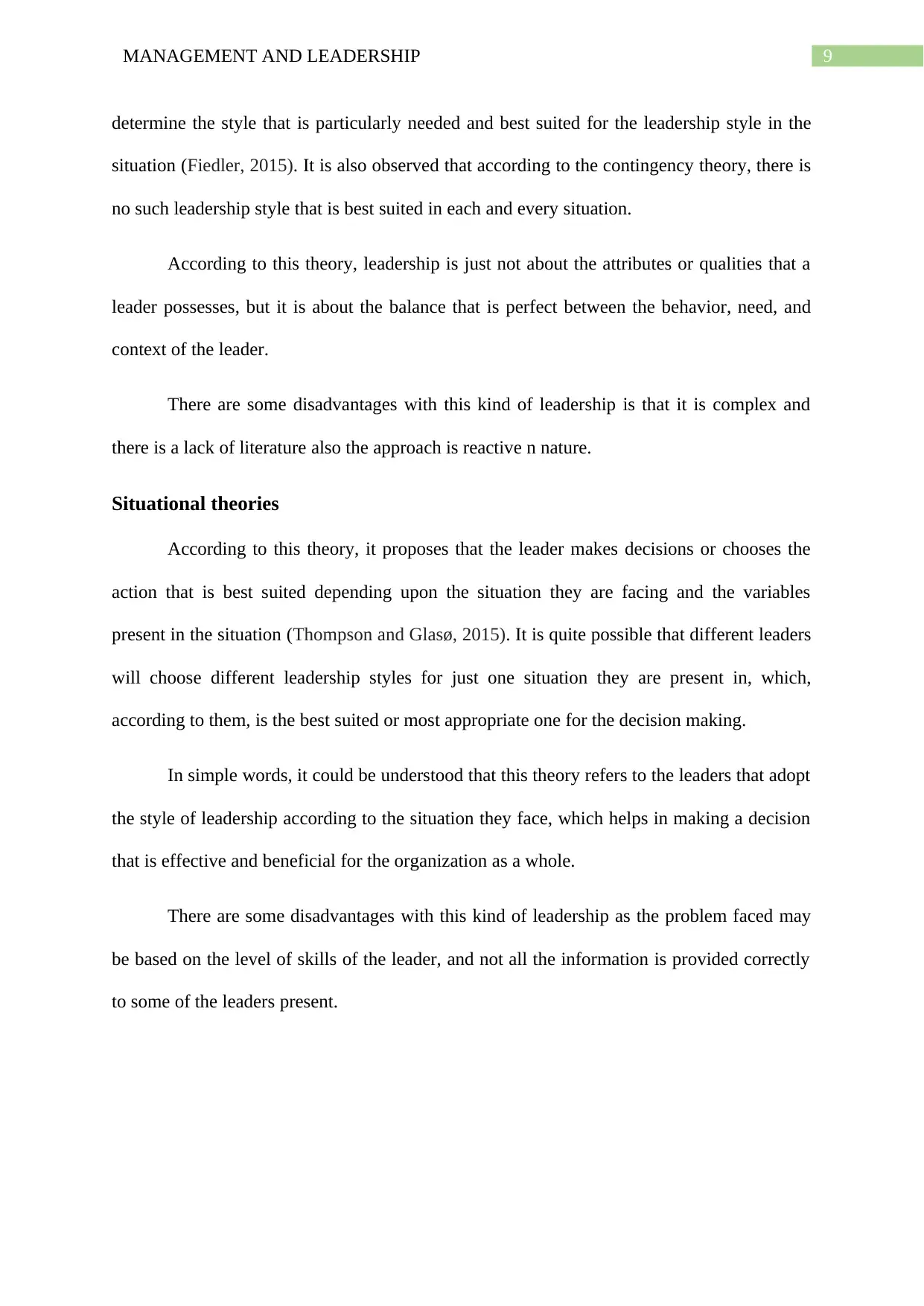
9MANAGEMENT AND LEADERSHIP
determine the style that is particularly needed and best suited for the leadership style in the
situation (Fiedler, 2015). It is also observed that according to the contingency theory, there is
no such leadership style that is best suited in each and every situation.
According to this theory, leadership is just not about the attributes or qualities that a
leader possesses, but it is about the balance that is perfect between the behavior, need, and
context of the leader.
There are some disadvantages with this kind of leadership is that it is complex and
there is a lack of literature also the approach is reactive n nature.
Situational theories
According to this theory, it proposes that the leader makes decisions or chooses the
action that is best suited depending upon the situation they are facing and the variables
present in the situation (Thompson and Glasø, 2015). It is quite possible that different leaders
will choose different leadership styles for just one situation they are present in, which,
according to them, is the best suited or most appropriate one for the decision making.
In simple words, it could be understood that this theory refers to the leaders that adopt
the style of leadership according to the situation they face, which helps in making a decision
that is effective and beneficial for the organization as a whole.
There are some disadvantages with this kind of leadership as the problem faced may
be based on the level of skills of the leader, and not all the information is provided correctly
to some of the leaders present.
determine the style that is particularly needed and best suited for the leadership style in the
situation (Fiedler, 2015). It is also observed that according to the contingency theory, there is
no such leadership style that is best suited in each and every situation.
According to this theory, leadership is just not about the attributes or qualities that a
leader possesses, but it is about the balance that is perfect between the behavior, need, and
context of the leader.
There are some disadvantages with this kind of leadership is that it is complex and
there is a lack of literature also the approach is reactive n nature.
Situational theories
According to this theory, it proposes that the leader makes decisions or chooses the
action that is best suited depending upon the situation they are facing and the variables
present in the situation (Thompson and Glasø, 2015). It is quite possible that different leaders
will choose different leadership styles for just one situation they are present in, which,
according to them, is the best suited or most appropriate one for the decision making.
In simple words, it could be understood that this theory refers to the leaders that adopt
the style of leadership according to the situation they face, which helps in making a decision
that is effective and beneficial for the organization as a whole.
There are some disadvantages with this kind of leadership as the problem faced may
be based on the level of skills of the leader, and not all the information is provided correctly
to some of the leaders present.
Paraphrase This Document
Need a fresh take? Get an instant paraphrase of this document with our AI Paraphraser

10MANAGEMENT AND LEADERSHIP
References
Amanchukwu, R.N., Stanley, G.J. and Ololube, N.P., 2015. A review of leadership theories,
principles and styles and their relevance to educational management. Management, 5(1),
pp.6-14.
Antonioni, D., 1998. Relationship between the big five personality factors and conflict
management styles. International journal of conflict management, 9(4).
Bethel, S.M., 2012. Making a difference: Twelve qualities that make you a leader. AudioInk.
Bush, T., 2008. Leadership and management development in education. Sage.
Chan, J.C., Sit, E.N. and Lau, W.M., 2014. Conflict management styles, emotional
intelligence and implicit theories of personality of nursing students: A cross-sectional
study. Nurse education today, 34(6), pp.934-939.
Coleman, M., 2000. The female secondary headteacher in England and Wales: leadership and
management styles. Educational Research, 42(1), pp.13-27.
Fiedler, F.R.E.D., 2015. Contingency theory of leadership. Organizational Behavior 1:
Essential Theories of Motivation and Leadership, 232, pp.01-2015.
Gonçalves, G., Reis, M., Sousa, C., Santos, J., Orgambídez-Ramos, A. and Scott, P., 2016.
Cultural intelligence and conflict management styles. International Journal of Organizational
Analysis.
Greenleaf, R.K., 2002. Servant leadership: A journey into the nature of legitimate power and
greatness. Paulist Press.
References
Amanchukwu, R.N., Stanley, G.J. and Ololube, N.P., 2015. A review of leadership theories,
principles and styles and their relevance to educational management. Management, 5(1),
pp.6-14.
Antonioni, D., 1998. Relationship between the big five personality factors and conflict
management styles. International journal of conflict management, 9(4).
Bethel, S.M., 2012. Making a difference: Twelve qualities that make you a leader. AudioInk.
Bush, T., 2008. Leadership and management development in education. Sage.
Chan, J.C., Sit, E.N. and Lau, W.M., 2014. Conflict management styles, emotional
intelligence and implicit theories of personality of nursing students: A cross-sectional
study. Nurse education today, 34(6), pp.934-939.
Coleman, M., 2000. The female secondary headteacher in England and Wales: leadership and
management styles. Educational Research, 42(1), pp.13-27.
Fiedler, F.R.E.D., 2015. Contingency theory of leadership. Organizational Behavior 1:
Essential Theories of Motivation and Leadership, 232, pp.01-2015.
Gonçalves, G., Reis, M., Sousa, C., Santos, J., Orgambídez-Ramos, A. and Scott, P., 2016.
Cultural intelligence and conflict management styles. International Journal of Organizational
Analysis.
Greenleaf, R.K., 2002. Servant leadership: A journey into the nature of legitimate power and
greatness. Paulist Press.
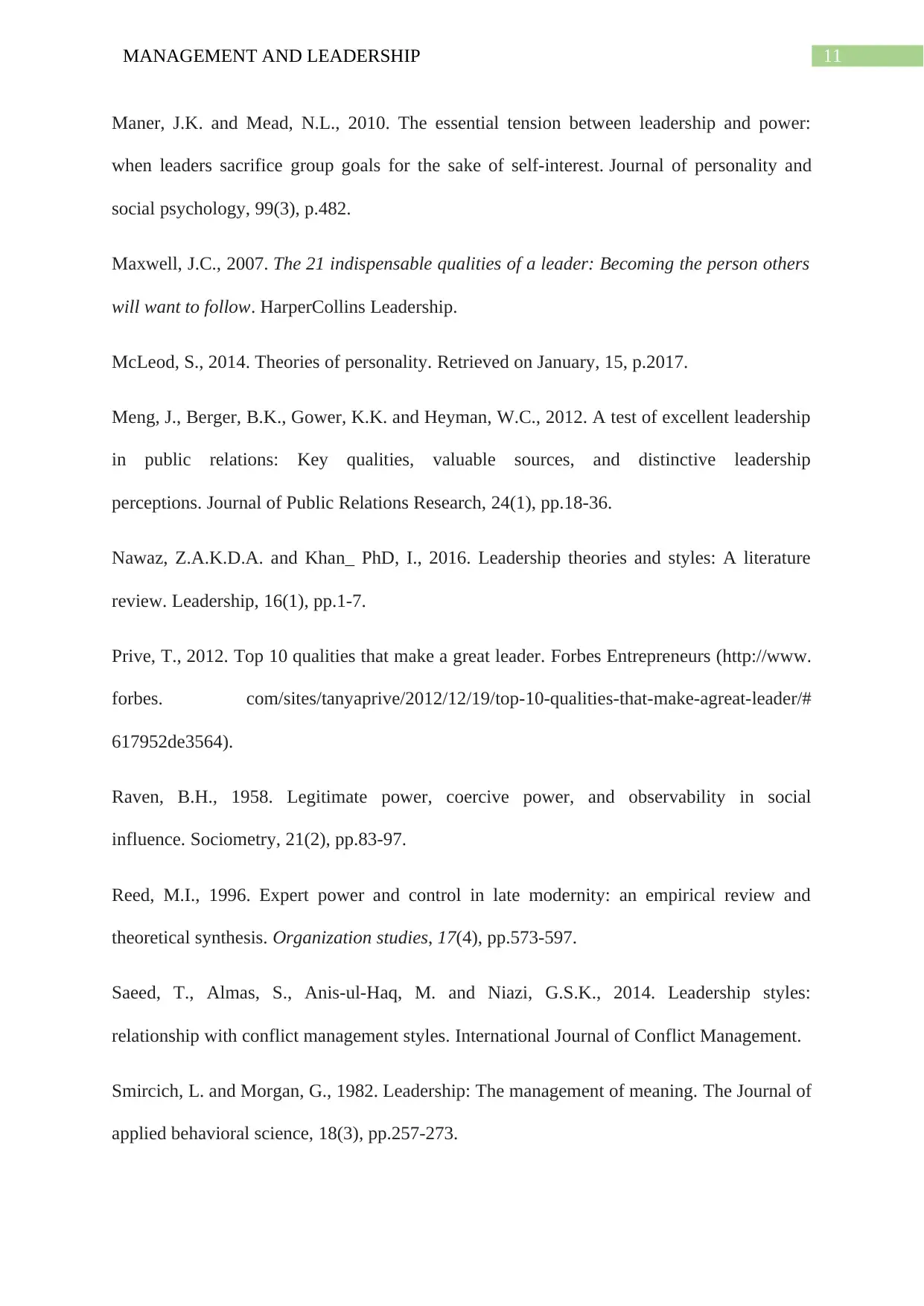
11MANAGEMENT AND LEADERSHIP
Maner, J.K. and Mead, N.L., 2010. The essential tension between leadership and power:
when leaders sacrifice group goals for the sake of self-interest. Journal of personality and
social psychology, 99(3), p.482.
Maxwell, J.C., 2007. The 21 indispensable qualities of a leader: Becoming the person others
will want to follow. HarperCollins Leadership.
McLeod, S., 2014. Theories of personality. Retrieved on January, 15, p.2017.
Meng, J., Berger, B.K., Gower, K.K. and Heyman, W.C., 2012. A test of excellent leadership
in public relations: Key qualities, valuable sources, and distinctive leadership
perceptions. Journal of Public Relations Research, 24(1), pp.18-36.
Nawaz, Z.A.K.D.A. and Khan_ PhD, I., 2016. Leadership theories and styles: A literature
review. Leadership, 16(1), pp.1-7.
Prive, T., 2012. Top 10 qualities that make a great leader. Forbes Entrepreneurs (http://www.
forbes. com/sites/tanyaprive/2012/12/19/top-10-qualities-that-make-agreat-leader/#
617952de3564).
Raven, B.H., 1958. Legitimate power, coercive power, and observability in social
influence. Sociometry, 21(2), pp.83-97.
Reed, M.I., 1996. Expert power and control in late modernity: an empirical review and
theoretical synthesis. Organization studies, 17(4), pp.573-597.
Saeed, T., Almas, S., Anis-ul-Haq, M. and Niazi, G.S.K., 2014. Leadership styles:
relationship with conflict management styles. International Journal of Conflict Management.
Smircich, L. and Morgan, G., 1982. Leadership: The management of meaning. The Journal of
applied behavioral science, 18(3), pp.257-273.
Maner, J.K. and Mead, N.L., 2010. The essential tension between leadership and power:
when leaders sacrifice group goals for the sake of self-interest. Journal of personality and
social psychology, 99(3), p.482.
Maxwell, J.C., 2007. The 21 indispensable qualities of a leader: Becoming the person others
will want to follow. HarperCollins Leadership.
McLeod, S., 2014. Theories of personality. Retrieved on January, 15, p.2017.
Meng, J., Berger, B.K., Gower, K.K. and Heyman, W.C., 2012. A test of excellent leadership
in public relations: Key qualities, valuable sources, and distinctive leadership
perceptions. Journal of Public Relations Research, 24(1), pp.18-36.
Nawaz, Z.A.K.D.A. and Khan_ PhD, I., 2016. Leadership theories and styles: A literature
review. Leadership, 16(1), pp.1-7.
Prive, T., 2012. Top 10 qualities that make a great leader. Forbes Entrepreneurs (http://www.
forbes. com/sites/tanyaprive/2012/12/19/top-10-qualities-that-make-agreat-leader/#
617952de3564).
Raven, B.H., 1958. Legitimate power, coercive power, and observability in social
influence. Sociometry, 21(2), pp.83-97.
Reed, M.I., 1996. Expert power and control in late modernity: an empirical review and
theoretical synthesis. Organization studies, 17(4), pp.573-597.
Saeed, T., Almas, S., Anis-ul-Haq, M. and Niazi, G.S.K., 2014. Leadership styles:
relationship with conflict management styles. International Journal of Conflict Management.
Smircich, L. and Morgan, G., 1982. Leadership: The management of meaning. The Journal of
applied behavioral science, 18(3), pp.257-273.
⊘ This is a preview!⊘
Do you want full access?
Subscribe today to unlock all pages.

Trusted by 1+ million students worldwide
1 out of 13
Related Documents
Your All-in-One AI-Powered Toolkit for Academic Success.
+13062052269
info@desklib.com
Available 24*7 on WhatsApp / Email
![[object Object]](/_next/static/media/star-bottom.7253800d.svg)
Unlock your academic potential
Copyright © 2020–2025 A2Z Services. All Rights Reserved. Developed and managed by ZUCOL.




